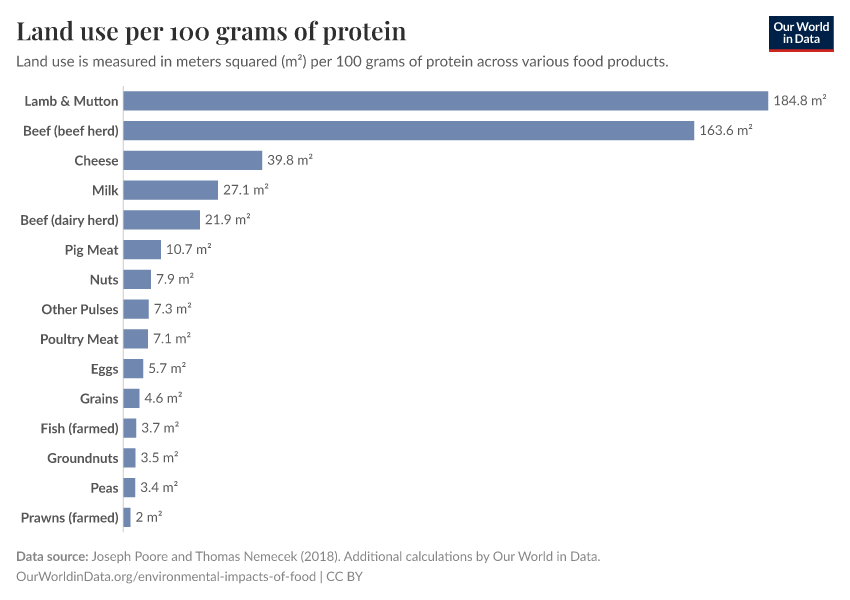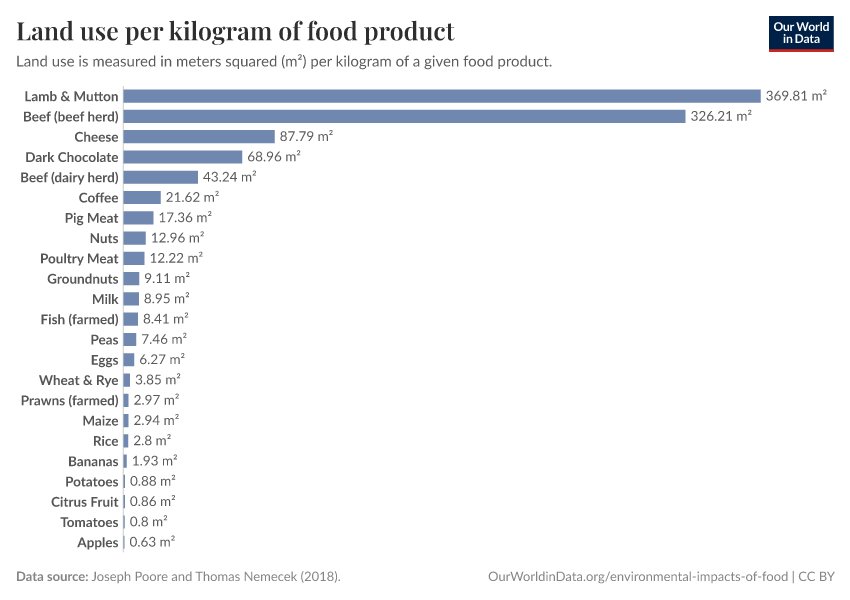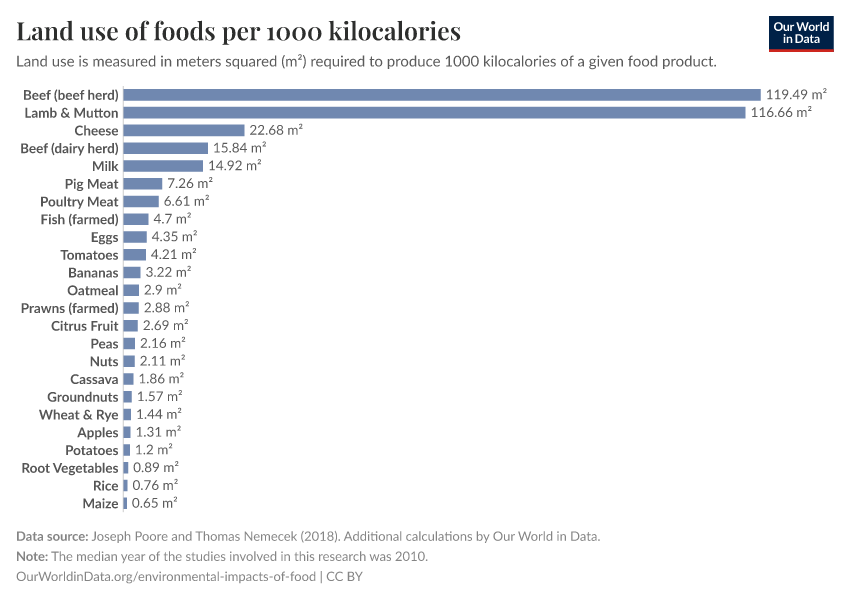If the world adopted a plant-based diet, we would reduce global agricultural land use from 4 to 1 billion hectares
We could reduce the amount of land used for grazing and croplands used to grow animal feed.
Summary
Half of the world’s habitable land is used for agriculture, with most of this used to raise livestock for dairy and meat. Livestock are fed from two sources – lands on which the animals graze and land on which feeding crops, such as soy and cereals, are grown. How much would our agricultural land use decline if the world adopted a plant-based diet?
Research suggests that if everyone shifted to a plant-based diet, we would reduce global land use for agriculture by 75%. This large reduction of agricultural land use would be possible thanks to a reduction in land used for grazing and a smaller need for land to grow crops. The research also shows that cutting out beef and dairy (by substituting chicken, eggs, fish, or plant-based food) has a much larger impact than eliminating chicken or fish.
The expansion of land for agriculture is the leading driver of deforestation and biodiversity loss.
Half of the world’s ice- and desert-free land is used for agriculture. Most of this is for raising livestock – the land requirements of meat and dairy production are equivalent to an area the size of the Americas, spanning all the way from Alaska to Tierra del Fuego.
The land use of livestock is so large because it takes 50 to 100 times as much land to produce a kilocalorie of beef or lamb versus plant-based alternatives. This is shown in the chart.1 The same is also true for protein – it takes almost 50 to 100 times as much land to produce a gram of protein from beef or lamb, versus peas or tofu.
Of course, the type of land used to raise cows or sheep is not the same as cropland for cereals, potatoes, or beans. Livestock can be raised on pasture grasslands or on steep hills where it is not possible to grow crops. Two-thirds of pastures are unsuitable for growing crops.2
This raises the question of whether we could, or should, stop using it for agriculture at all. We could let natural vegetation and ecosystems return to these lands, which would have large benefits for biodiversity and carbon sequestration.3 In an upcoming article we will look at the carbon opportunity costs of using land for agriculture.
One concern is whether we would be able to grow enough food for everyone on the cropland that is left. The research suggests that it’s possible to feed everyone in the world a nutritious diet on existing croplands, but only if we see a widespread shift towards plant-based diets.
Related charts

Land use of foods per 100 grams of protein

Land use of foods per kilogram
More plant-based diets tend to need less cropland
If we would shift towards a more plant-based diet we don’t only need less agricultural land overall, we also need less cropland. This might go against our intuition: if we substitute beans, peas, tofu and cereals for meat and dairy, surely we would need more cropland to grow them?
Let’s look at why this is not the case. In the chart here we see the amount of agricultural land the world would need to provide food for everyone. This comes from the work of Joseph Poore and Thomas Nemecek, the largest meta-analysis of global food systems to date.4 The top bar shows the current land use based on the global average diet in 2010.
As we see, almost three-quarters of this land is used as pasture, the remaining quarter is cropland.5 If we combine pastures and cropland for animal feed, around 80% of all agricultural land is used for meat and dairy production.
This has a large impact on how land requirements change as we shift towards a more plant-based diet. If the world population ate less meat and dairy we would be eating more crops. The consequence – as the following bar chart shows – would be that the ‘human food’ component of cropland would increase while the land area used for animal feed would shrink.6
In the hypothetical scenario in which the entire world adopted a vegan diet the researchers estimate that our total agricultural land use would shrink from 4.1 billion hectares to 1 billion hectares. A reduction of 75%. That’s equal to an area the size of North America and Brazil combined.
But importantly large land use reductions would be possible even without a fully vegan diet. Cutting out beef, mutton and dairy makes the biggest difference to agricultural land use as it would free up the land that is used for pastures. But it’s not just pasture; it also reduces the amount of cropland we need.
This is an important insight from this research: cutting out beef and dairy (by substituting chicken, eggs, fish, or plant-based food) has a much larger impact than eliminating chicken or fish.
Less than half of the world’s cereals are fed directly to humans
How is it possible that producing more crops for human consumption needs less cropland? The answer becomes clear when we step back and look at the bigger picture of how much crop we actually produce, and how this is used.
In the chart, we see the breakdown of what the world’s cereals are used for. This is split into three categories: direct human food (the rice, oats, wheat, bread, etc. that we eat); animal feed; and industrial uses (mainly biofuels).
Less than half – only 48% – of the world’s cereals are eaten by humans. 41% is used for animal feed and 11% for biofuels.
In many countries, the share that is for human consumption is even smaller. We see this in the map. In most countries across Europe, it’s less than one-third of cereal production is used for human consumption, and in the US only 10% is.7
It’s not just cereals that are diverted towards animal feed and biofuels. It’s also true of many oil crops. As we explain in more detail here, only 7% of soy goes towards human foods such as tofu, tempeh, soy milk, and other substitute products. Most of the rest goes towards oil production which is split between soybean meal for animal feed and soybean oil. These are co-products, although, by economic value, animal feed dominates.
Livestock waste a lot of energy and protein, but do produce more nutrient-dense protein sources
Cereals fed to animals are not wasted: they are converted to meat and dairy, and consumed by humans in the end. But, in terms of calories and total protein, this process is very inefficient. [What’s true is that animals do produce high-quality, micronutrient-rich protein – see the box on this below].8 When you feed an animal, not all of this energy goes into producing additional meat, milk, or eggs. Most of the energy is used to simply keep the animal alive. This is exactly the same for us: most of the calories we eat are used to keep us alive and maintain our body weight. It’s only when we eat in excess that we gain weight.
In the charts here we see the energy and protein efficiency of different animal products.9 This tells us what percentage of the calories or grams of protein that we feed livestock are later available to consume as meat and dairy. As an example: beef has an energy efficiency of about 2%. This means that for every 100 kilocalories you feed a cow, you only get 2 kilocalories of beef back. In general, we see that cows are the least efficient, followed by lamb, pigs then poultry. As a rule of thumb: smaller animals are more efficient. That’s why chicken and fish tend to have a lower environmental impact.
This is why eating less meat would mean eliminating large losses of calories and thereby reducing the amount of farmland we need. This would free up billions of hectares for natural vegetation, forests, and ecosystems to return.
More of our articles on this topic:
Food production is responsible for one-quarter of the world’s greenhouse gas emissions
You want to reduce the carbon footprint of your food? Focus on what you eat, not whether your food is local
How does the carbon footprint of foods compare across the world?
Endnotes
This data is based on the global median land use of different food products as presented in Poore and Nemecek (2018). This meta-analysis looked at the environmental impacts of foods covering 38,000 farms in 119 countries. For some foods there is significant variability from the median land use depending on how it is produced.
Poore, J., & Nemecek, T. (2018). Reducing food’s environmental impacts through producers and consumers. Science, 360(6392), 987-992.
An estimated 65% of land used for grass for grazing cattle is not suitable for growing crops.
Mottet, A., de Haan, C., Falcucci, A., Tempio, G., Opio, C., & Gerber, P. (2017). Livestock: on our plates or eating at our table? A new analysis of the feed/food debate. Global Food Security, 14, 1-8.
Poore, J., & Nemecek, T. (2018). Reducing food’s environmental impacts through producers and consumers. Science, 360(6392), 987-992.
Hayek, M. N., Harwatt, H., Ripple, W. J., & Mueller, N. D. (2020). The carbon opportunity cost of animal-sourced food production on land. Nature Sustainability, 1-4.
Poore, J., & Nemecek, T. (2018). Reducing food’s environmental impacts through producers and consumers. Science, 360(6392), 987-992.
Note that this breakdown of agricultural land use differs slightly from the breakdown of global land use from the UN Food and Agriculture Organization (FAO) for a few reasons. First, this view only includes cropland and pasture used to produce food. Allocation of crops towards industrial uses e.g. biofuels is not included. In UN FAO breakdowns, it is included. Secondly, the amount of land that qualifies as ‘pasture’ depends on definitions surrounding livestock density and other aspects of land management. The extent of ‘rangelands’ – land used to raise livestock but at a relatively low density – can vary from study to study. So, while the UN FAO data suggests that 50% of habitable land is used for agriculture, Poore and Nemecek (2018) put this figure at 43%.
This data is sourced from the meta-analysis study by Joseph Poore and Thomas Nemecek (2018), published in Science. Many other studies have looked at this question and found exactly the same result: if everyone shifted to a vegan diet, we would need less agricultural land (and cropland) specifically.
Hayek, M. N., Harwatt, H., Ripple, W. J., & Mueller, N. D. (2020). The carbon opportunity cost of animal-sourced food production on land. Nature Sustainability, 1-4.
Searchinger, T. D., Wirsenius, S., Beringer, T., & Dumas, P. (2018). Assessing the efficiency of changes in land use for mitigating climate change. Nature, 564(7735), 249-253.
There is a strong rich-poor split across countries: people in poorer countries get most of their calories from cereals as they cannot afford much meat and dairy. This means they cannot afford to divert cereals towards livestock or biofuels. In India, 93% of cereals are consumed by humans; 95% in Kenya; and 96% in Botswana.
Tilman, D., & Clark, M. (2014). Global diets link environmental sustainability and human health. Nature, 515(7528), 518-522.
Shepon, A., Eshel, G., Noor, E., & Milo, R. (2016). Energy and protein feed-to-food conversion efficiencies in the US and potential food security gains from dietary changes. Environmental Research Letters, 11(10), 105002.
This is shown as the average conversion efficiency. It can vary a bit depending on the breed of livestock, what they’re fed, and how they’re managed. But the overall magnitudes are similar.
Alexander, P., Brown, C., Arneth, A., Finnigan, J., & Rounsevell, M. D. (2016). Human appropriation of land for food: The role of diet. Global Environmental Change, 41, 88-98.
World Health Organization, & United Nations University. (2007). Protein and amino acid requirements in human nutrition (Vol. 935). World Health Organization.
One way of comparing the quality of different protein sources is by using their Protein Digestibility-Corrected Amino Acid Score (PDCAAS). This score looks not only at the total protein they provide but also at digestibility, and whether there are particular deficiencies of specific amino acids. Cereals in particular are often limited in the amino acid, lysine. This gives them a low PDCAAS score of 42, compared to beef which achieves 92.
Schaafsma, G. (2000). The protein digestibility–corrected amino acid score. The Journal of Nutrition, 130(7), 1865S-1867S.
Young, V. R., & Pellett, P. L. (1994). Plant proteins in relation to human protein and amino acid nutrition. The American Journal of Clinical Nutrition, 59(5), 1203S-1212S.
As we noted earlier, protein quality can be scored in terms of its Protein Digestibility-Corrected Amino Acid Score (PDCAAS). Soy achieves a PDCAAS of 0.92, comparable to beef at 0.94.
Schaafsma, G. (2000). The protein digestibility–corrected amino acid score. The Journal of Nutrition, 130(7), 1865S-1867S.
Cite this work
Our articles and data visualizations rely on work from many different people and organizations. When citing this article, please also cite the underlying data sources. This article can be cited as:
Hannah Ritchie (2021) - “If the world adopted a plant-based diet, we would reduce global agricultural land use from 4 to 1 billion hectares” Published online at OurWorldinData.org. Retrieved from: 'https://ourworldindata.org/land-use-diets' [Online Resource]BibTeX citation
@article{owid-land-use-diets,
author = {Hannah Ritchie},
title = {If the world adopted a plant-based diet, we would reduce global agricultural land use from 4 to 1 billion hectares},
journal = {Our World in Data},
year = {2021},
note = {https://ourworldindata.org/land-use-diets}
}Reuse this work freely
All visualizations, data, and code produced by Our World in Data are completely open access under the Creative Commons BY license. You have the permission to use, distribute, and reproduce these in any medium, provided the source and authors are credited.
The data produced by third parties and made available by Our World in Data is subject to the license terms from the original third-party authors. We will always indicate the original source of the data in our documentation, so you should always check the license of any such third-party data before use and redistribution.
All of our charts can be embedded in any site.






